-

新人教版高中英语选修2Unit 5 Using langauge-Listening教学设计
The theme of this section is to learn how to make emergency calls. Students should learn how to make emergency calls not only in China, but also in foreign countries in English, so that they can be prepared for future situations outside the home.The emergency telephone number is a vital hotline, which should be the most clear, rapid and effective communication with the acute operator.This section helps students to understand the emergency calls in some countries and the precautions for making emergency calls. Through the study of this section, students can accumulate common expressions and sentence patterns in this context. 1.Help students accumulate emergency telephone numbers in different countries and learn more about first aid2.Guide the students to understand the contents and instructions of the telephone, grasp the characteristics of the emergency telephone and the requirements of the emergency telephone.3.Guide students to understand the first aid instructions of the operators.4.Enable Ss to make simulated emergency calls with their partners in the language they have learned1. Instruct students to grasp the key information and important details of the dialogue.2. Instruct students to conduct a similar talk on the relevant topic.Step1:Look and discuss:Match the pictures below to the medical emergencies, and then discuss the questions in groups.
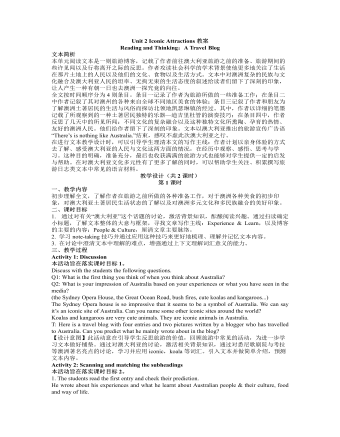
新人教版高中英语选修4Unit 2 Iconic Attractions教案
帮助学生通过讨论与对主题的提升,反思自己的旅游方式,以便做出更优化的安排,在今后的旅程中有更多的收益。 Activity 2: Further discussion of the 6 elements above and supplement of more background knowledge 本活动为实现课时教学目标2。 1.Target Q: The writer’s clear target of traveling, meeting the people and experiencing the culture, is closely related to his major in social studies. Then what is social studies? Social studies is a part of a school or college curriculum concerned with the study of social relationships and the functioning of society and usually made up of courses in history, government, economics, civics, sociology, geography, and anthropology. (Dictionary by Merriam-Webster) Reflection: When you go out to travel, what targets do you usually have in mind? 2.Research Q: Suppose you are traveling to Hangzhou during the school holidays, how will you do research on the city? (surf the internet, read books or travel brochures, consult friends, ...) What information will you be interested to know? (location, iconic sites, local cuisines, interesting customs, shopping malls ...) 3.Abandonment To make the most of time, we have to learn to abandon so that we can accomplish our plan. What will you be interested in doing if you go to Hangzhou if you have a week’s time? What if you only have 2 days? 4~5. Venturing & Experiencing Q: What did he venture to do during the trip? What new experiences did he have? In Sydney: attend his first open-air barbecue, enjoy many different but yummy meals In Catherine: observe the life and customs of the aborigines appreciate their music & try the musical instruments: the didgeridoo
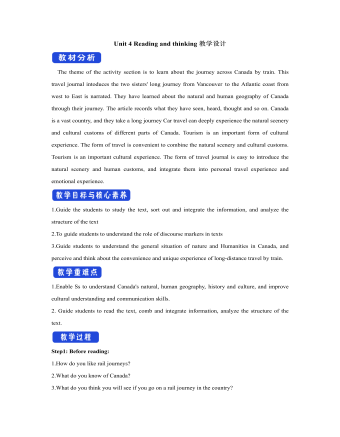
新人教版高中英语选修2Unit 4 Reading and thinking教学设计
【词汇精讲】highlight n.最好或最精彩的部分 vt.突出;强调;使醒目One of the highlights of the trip was seeing the Taj Mahal.这次旅行的亮点之一是参观泰姬陵。Your resume should highlight your skills and achievements.你的简历应该突出你的技能和成就。The report highlights the major problems facing society today.报告强调了当今社会所面临的主要问题。I’ve highlighted the important passages in yellow.我用黄色标出了重要段落。7.Edmonton is freezing cold in winter,with daily temperatures averaging -10 ℃.埃德蒙顿冬季寒冷,日平均气温为-10°C。【词汇精讲】freezing adj.极冷的;冰冻的Leave a basin of water outside in freezing weather.在冰冻的天气里,放一盆水在室外。It’s freezing cold outside so wear a warm coat.外面超冷的,所以穿一个暖和一点的外套吧。8.It was not until 9:30 a.m.that they finally reached the capital of Ontario,Toronto.直到上午9时30分,他们才终于到达多伦多的首府安大略省。【句式剖析】本句是一个强调句,强调的是句子的时间状语until 9:30。含有not...until...的句子的强调句为It is not until...that...,that后面的句子要用肯定形式。It was not until then that I suddenly realized nobody was happier than I was.直到那时我才突然意识到没有人比我更幸福了。
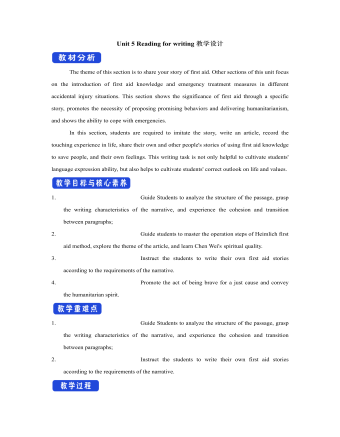
新人教版高中英语选修2Unit 5 Reading for writing教学设计
你校英语报计划出版一期急救常识专刊,现面向全校学生公开征集稿件,你有意参加。请你根据下面提示内容,用英语写一篇短文,介绍在车祸现场对伤者进行急救的方法和步骤。1.确保现场的安全;2.询问伤者,确保其呼吸正常;3.检查伤口,如流血则应采取止血措施;4.如需急救,确保其处于康复位置。注意:1.词数80左右;2.可以适当增加细节,以使行文连贯。参考词汇:康复位置 recovery positionAs we all know, having a knowledge of first aid can make a great difference in our daily life. If a traffic accident happens and someone is injured, the following steps can be used to treat the injured.In the first place, we should make sure that the accident scene is safe so that we won’t get hurt. We should ask the injured person if he is OK, and see if he is breathing. What’s more, we should check for cuts and wounds. If he is bleeding badly, it is vital that we should try to stop the bleeding by applying pressure to the injury. This is because if a person loses too much blood, he may die. If necessary, take the injured person to the hospital as soon as possible.Do remember: when giving first aid, please be sure to place the person in a recovery position.
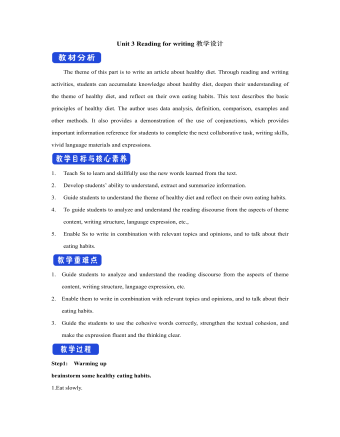
新人教版高中英语选修2Unit 3 Reading for writing教学设计
The theme of this part is to write an article about healthy diet. Through reading and writing activities, students can accumulate knowledge about healthy diet, deepen their understanding of the theme of healthy diet, and reflect on their own eating habits. This text describes the basic principles of healthy diet. The author uses data analysis, definition, comparison, examples and other methods. It also provides a demonstration of the use of conjunctions, which provides important information reference for students to complete the next collaborative task, writing skills, vivid language materials and expressions.1. Teach Ss to learn and skillfully use the new words learned from the text.2. Develop students’ ability to understand, extract and summarize information.3. Guide students to understand the theme of healthy diet and reflect on their own eating habits.4. To guide students to analyze and understand the reading discourse from the aspects of theme content, writing structure, language expression, etc., 5. Enable Ss to write in combination with relevant topics and opinions, and to talk about their eating habits.1. Guide students to analyze and understand the reading discourse from the aspects of theme content, writing structure, language expression, etc.2. Enable them to write in combination with relevant topics and opinions, and to talk about their eating habits.3. Guide the students to use the cohesive words correctly, strengthen the textual cohesion, and make the expression fluent and the thinking clear.Step1: Warming upbrainstorm some healthy eating habits.1.Eat slowly.2.Don’t eat too much fat or sugar.3.Eat healthy food.4.Have a balanced diet.Step2: Read the passage and then sum up the main idea of each paragraph.

新人教版高中英语选修2Unit 4 Reading for writing教学设计
假定你是英国的Jack,打算来中国旅行,请你给你的中国笔友李华写一封信,要点如下:1.你的旅行计划:北京→泰山→杭州;2.征求建议并询问他是否愿意充当你的导游。注意:1.词数80左右(开头和结尾已给出,不计入总词数);2.可以适当增加细节,以使行文连贯。参考词汇:故宫 the Forbidden City;泰山 Mount TaiDear Li Hua,I'm glad to tell you that 'm going to visit China.First,I am planning to visit Beijing,the capitalof China,where I am looking forward to enjoying the Great Wall,the Forbidden City and somebeautiful parks.Then I intend to go to visit Mount Tai in Shandong Province.I've heard that it is one ofthe most famous mountains in China and I can't wait to enjoy the amazing sunrise there.After that,I amalso going to Hangzhou.It is said that it is a beautiful modern city with breathtaking natural sights,among which the West Lake is a well- known tourist attraction.What do you think of my travel plan? Will you act as my guide? Hope to hear from you soon.

新人教版高中英语选修2Unit 5 Learning about Language教学设计
The purpose of this section of vocabulary exercises is to consolidate the key words in the first part of the reading text, let the students write the words according to the English definition, and focus on the detection of the meaning and spelling of the new words. The teaching design includes use English definition to explain words, which is conducive to improving students' interest in vocabulary learning, cultivating their sense of English language and thinking in English, and making students willing to use this method to better grasp the meaning of words, expand their vocabulary, and improve their ability of vocabulary application. Besides, the design offers more context including sentences and short passage for students to practice words flexibly.1. Guide students to understand and consolidate the meaning and usage of the vocabulary in the context, 2. Guide the students to use the unit topic vocabulary in a richer context3. Let the students sort out and accumulate the accumulated vocabulary, establishes the semantic connection between the vocabulary,4. Enable students to understand and master the vocabulary more effectivelyGuiding the Ss to use unit topic words and the sentence patterns in a richer context.Step1: Read the passage about chemical burns and fill in the blanks with the correct forms of the words in the box.

新人教版高中英语选修2Unit 5 Reading and thinking教学设计
The theme of this activity is to learn the first aid knowledge of burns. Burns is common in life, but there are some misunderstandings in manual treatment. This activity provides students with correct first aid methods, so as not to take them for granted in an emergency. This section guides students to analyze the causes of scald and help students avoid such things. From the perspective of text structure and collaborative features, the text is expository. Expository, with explanation as the main way of expression, transmits knowledge and information to readers by analyzing concepts and elaborating examples. This text arranges the information in logical order, clearly presents three parts of the content through the subtitle, accurately describes the causes, types, characteristics and first aid measures of burns, and some paragraphs use topic sentences to summarize the main idea, and the level is very clear.1. Guide students to understand the causes, types, characteristics and first aid methods of burns, through reading2. Enhance students’ ability to deal withburnss and their awareness of burns prevention3. Enable students to improve the ability to judge the types of texts accurately and to master the characteristics and writing techniques of expository texts.Guide students to understand the causes, types, characteristics and first aid methods of burns, through readingStep1: Lead in by discussing the related topic:1. What first-aid techniques do you know of ?CPR; mouth to mouth artificial respiration; the Heimlich Manoeuvre
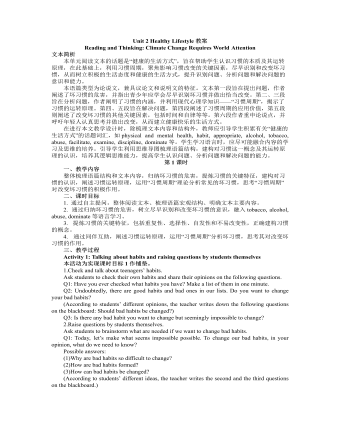
新人教版高中英语选修3Unit 2 Healthy Lifestyle教案
Activity 4: Figuring out the structure and the writing purpose 本活动为实现课时目标2。 1.Read Paragraph 6 and think about its main idea and the writer’s writing purpose. Q1: If you were the author, how would you end your article? “For young people, there is plenty of time to change bad habits. However, there is no “magic pill” or delete button that will help you; you have to think about your bad habits and decide on some changes. You have the power to build a happy and healthy life full of good habits!” Q2: What is Paragraph 6 mainly about? (Possible answer: to appeal to young people including teenagers to change bad habits and live a happy and healthy life.) 2.Think about the writer’s writing purpose and share opinions. Q1: What is the writing purpose? Work in pairs and figure it out. (Possible answer: On the one hand, the passage is written to help teenagers change their bad habits and live a healthy lifestyle. On the other hand, it provides us with a scientific way to identify and analyse our problems objectively, thus strengthening our resolve to tackle the seemingly common yet tough problems in our lives.) 【设计意图】 步骤1旨在预测和验证文章最后一段主要内容,梳理完整的语篇结构,步骤2旨在思考和讨论作者的写作目的。教师也可根据学生课堂反应情况融入对语篇人称多次转换的思考。
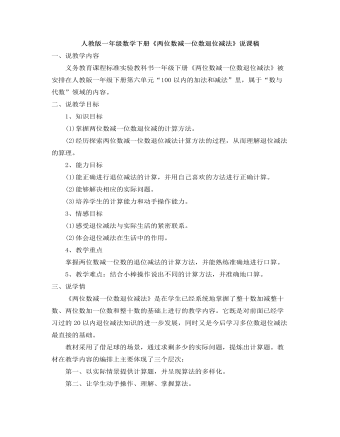
小学数学人教版一年级下册《两位数减一位数退位减法》说课稿
一、说教学内容义务教育课程标准实验教科书一年级下册《两位数减一位数退位减法》被安排在人教版一年级下册第六单元“100以内的加法和减法”里,属于“数与代数”领域的内容。二、说教学目标1、知识目标(1)掌握两位数减一位数退位减的计算方法。(2)经历探索两位数减一位数退位减法计算方法的过程,从而理解退位减法的算理。2、能力目标(1)能正确进行退位减法的计算,并用自己喜欢的方法进行正确计算。(2)能够解决相应的实际问题。(3)培养学生的计算能力和动手操作能力。3、情感目标(1)感受退位减法与实际生活的紧密联系。(2)体会退位减法在生活中的作用。4、教学重点掌握两位数减一位数的退位减法的计算方法,并能熟练准确地进行口算。 5、教学难点:结合小棒操作说出不同的计算方法,并准确地口算。
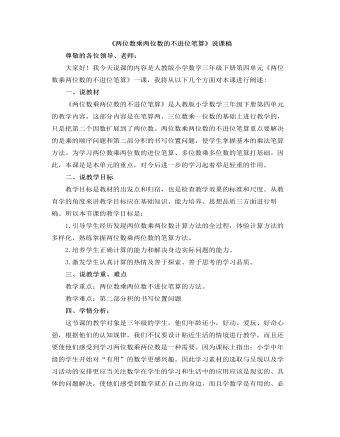
小学数学人教版三年级下册《两位数乘两位数的不进位笔算》说课稿
尊敬的各位领导、老师:大家好!我今天说课的内容是人教版小学数学三年级下册第四单元《两位数乘两位数的不进位笔算》一课,我将从以下几个方面对本课进行阐述:一、说教材《两位数乘两位数的不进位笔算》是人教版小学数学三年级下册第四单元的教学内容。这部分内容是在笔算两、三位数乘一位数的基础上进行教学的,只是把第二个因数扩展到了两位数。两位数乘两位数的不进位笔算重点要解决的是乘的顺序问题和第二部分积的书写位置问题,使学生掌握基本的乘法笔算方法。为学习两位数乘两位数的进位笔算、多位数乘多位数的笔算打基础。因此,本课是是本单元的重点,对今后进一步的学习起着举足轻重的作用。二、说教学目标教学目标是教材的出发点和归宿,也是检查教学效果的标准和尺度。从教育学的角度来讲教学目标应在基础知识、能力培养、思想品质三方面进行明确。所以本节课的教学目标是:

部编人教版五年级下册《人物描写一组》说课稿
二、说教学目标及重难点:1.教学目标 :(1)自主学习字词,会认“噶、绊”等12个生字,会写“搂、仗”等15个生字,理解字义,识记字形。正确读写和理解“手疾眼快、一叉一搂、公鸡鹐架、冷绊子、挺脱、诸亲六眷、监生、一声不倒一声、已后、登时”等词语。(2)正确、流利地朗读课文,体会人物的性格特点,感受小嘎子、车夫、严监生这三个鲜活的人物形象。(3)理解课文内容,学习作者抓住人物的动作、语言、外貌、心理活动等描写人物的方法,学习表现人物某一方面特点的写作方法。(4)激发学生阅读中外名著的兴趣。2.教学重点:体会人物的性格特点,感受小嘎子、车夫、严监生这三个鲜活的人物形象。3.教学难点:学习作者抓住人物的动作、语言、外貌、心理活动等描写人物的方法,学习表现人物某一方面特点的写作方法。
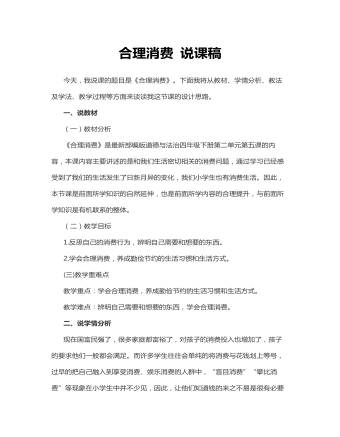
合理消费 说课稿
一、说教材(一)教材分析《合理消费》是最新部编版道德与法治四年级下册第二单元第五课的内容,本课内容主要讲述的是和我们生活密切相关的消费问题,通过学习已经感受到了我们的生活发生了日新月异的变化,我们小学生也有消费生活。因此,本节课是前面所学知识的自然延伸,也是前面所学内容的合理提升,与前面所学知识是有机联系的整体。(二)教学目标1.反思自己的消费行为,辨明自己需要和想要的东西。2.学会合理消费,养成勤俭节约的生活习惯和生活方式。(三)教学重难点教学重点:学会合理消费,养成勤俭节约的生活习惯和生活方式。教学难点:辨明自己需要和想要的东西,学会合理消费。二、说学情分析现在国富民强了,很多家庭都富裕了,对孩子的消费投入也增加了,孩子的要求他们一般都会满足。而许多学生往往会单纯的将消费与花钱划上等号,过早的把自己融入到享受消费、娱乐消费的人群中,“盲目消费”“攀比消费”等现象在小学生中并不少见,因此,让他们知道钱的来之不易是很有必要的。只有这样,才能促使学生认真思考“怎样使用手中所积攒下来的钱,才能意识到要合理消费。
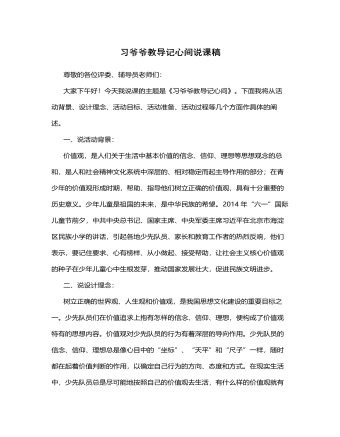
习爷爷教导记心间说课稿
〖设计意图:使少先队员更深刻更正确地领悟价值观的重要作用,初步树立了正确的价值观,下决心在价值观的引导下调整好自身的精神面貌与行为取向。〗第四版块:快乐宣誓——品味价值通过以上环节的活动,少先队员已经深深意识到:树立正确价值观的重要性。在此基础上的第四环节以深化主题,提高少先队员思想认识为目的。全体少先队员共同宣誓将本次活动推向高潮。以上四个环节由浅入深,层层递进,充分调动了少先队员的多种感官参与活动,促进了少先队员身心和能力的发展,顺理成章的达到了本次活动的目的。最后中队辅导员做总结,结束本次队会。“同学们, 这次主题队会开得很有意义,也很成功。通过对习爷爷讲话和社会主义核心价值观的学习,你们对社会主义核心价值观有了进一步的了解。希望你们今后能主动加强自我修养,不断提高自身素质,树立社会主义核心价值观,争做文明守纪好少先队员,自觉成为社会主义事业的建设者和接班人。”
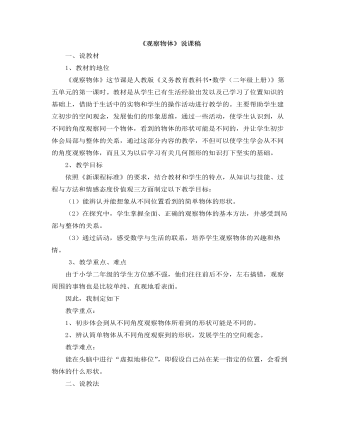
小学数学人教版二年级上册《观察物体》说课稿
1、教材的地位《观察物体》这节课是人教版《义务教育教科书?数学(二年级上册)》第五单元的第一课时。教材是从学生已有生活经验出发以及已学习了位置知识的基础上,借助于生活中的实物和学生的操作活动进行教学的。主要帮助学生建立初步的空间观念,发展他们的形象思维,通过一些活动,使学生认识到,从不同的角度观察同一个物体,看到的物体的形状可能是不同的,并让学生初步体会局部与整体的关系,通过这部分内容的教学,不但可以使学生学会从不同的角度观察物体,而且又为以后学习有关几何图形的知识打下坚实的基础。 2、教学目标依照《新课程标准》的要求,结合教材和学生的特点,从知识与技能、过程与方法和情感态度价值观三方面制定以下教学目标:(1)能辨认并能想象从不同位置看到的简单物体的形状。 (2)在探究中,学生掌握全面、正确的观察物体的基本方法,并感受到局部与整体的关系。 (3)通过活动,感受数学与生活的联系,培养学生观察物体的兴趣和热情。3、教学重点、难点由于小学二年级的学生方位感不强,他们往往前后不分,左右搞错,观察周围的事物也是比较单纯、直观地看表面。
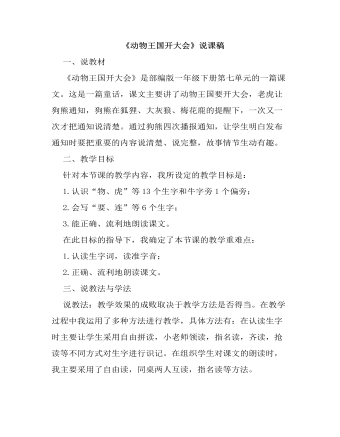
部编人教版一年级下册《动物王国开大会》(说课稿)
三、说教法与学法说教法:教学效果的成败取决于教学方法是否得当。在教学过程中我运用了多种方法进行教学,具体方法有:在认读生字时主要让学生采用自由拼读,小老师领读,指名读,齐读,抢读等不同方式对生字进行识记。在组织学生对课文的朗读时,我主要采用了自由读,同桌两人互读,指名读等方法。说学法:根据一年级学生特点及本节课的目标,本节课主要指导学生采用自主探究、合作交流、成果展示法的学习方法,开展学习活动。四、说教学过程为了更好、更有效地落实教学目标,突出重点,突破难点,我的教学流程有以下四大板块。(一) 情境导入,激发兴趣1.导课环节,首先利用多媒体向学生播放老虎、狗熊、狐狸、梅花鹿等图片,并配以音乐,让学生根据图片说出动物的名字,在轻松、愉悦的氛围中进入新课的学习——《动物王国开大会》。2.在板书课题时,相机教学“动物”的“物”字,在这里要读轻声,认识牛字旁。3.再次齐读课题。
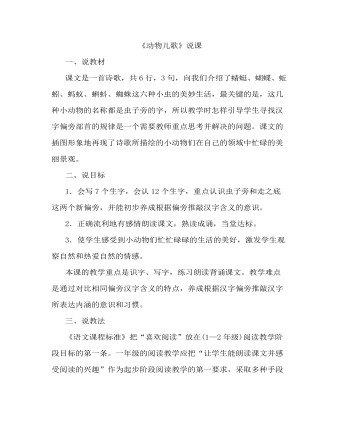
部编人教版一年级下册识字《动物儿歌》(说课稿)
一、说教材课文是一首诗歌,共6行,3句,向我们介绍了蜻蜓、蝴蝶、蚯蚓、蚂蚁、蝌蚪、蜘蛛这六种小虫的美妙生活,最关键的是,这几种小动物的名称都是虫子旁的字,所以教学时怎样引导学生寻找汉字偏旁部首的规律是一个需要教师重点思考并解决的问题。课文的插图形象地再现了诗歌所描绘的小动物们在自己的领域中忙碌的美丽景观。二、说目标1.会写7个生字,会认12个生字,重点认识虫子旁和走之底这两个新偏旁,并能初步养成根据偏旁推敲汉字含义的意识。2.正确流利地有感情朗读课文,熟读成诵,当堂达标。3.使学生感受到小动物们忙忙碌碌的生活的美好,激发学生观察自然和热爱自然的情感。本课的教学重点是识字、写字,练习朗读背诵课文。教学难点是通过对比相同偏旁汉字含义的特点,养成根据汉字偏旁推敲汉字所表达内涵的意识和习惯。
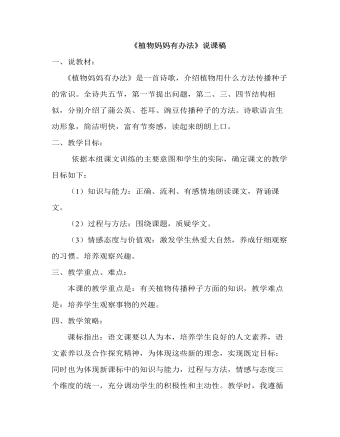
部编人教版二年级上册《植物妈妈有办法》说课稿
一、说教材:《植物妈妈有办法》是一首诗歌,介绍植物用什么方法传播种子的常识。全诗共五节,第一节提出问题,第二、三、四节结构相似,分别介绍了蒲公英、苍耳、豌豆传播种子的方法。诗歌语言生动形象,简洁明快,富有节奏感,读起来朗朗上口。 二、教学目标:依据本组课文训练的主要意图和学生的实际,确定课文的教学目标如下: (1)知识与能力:正确、流利、有感情地朗读课文,背诵课文。(2)过程与方法:围绕课题,质疑学文。(3)情感态度与价值观:激发学生热爱大自然,养成仔细观察的习惯。培养观察兴趣。 三、教学重点、难点:本课的教学重点是:有关植物传播种子方面的知识,教学难点是:培养学生观察事物的兴趣。
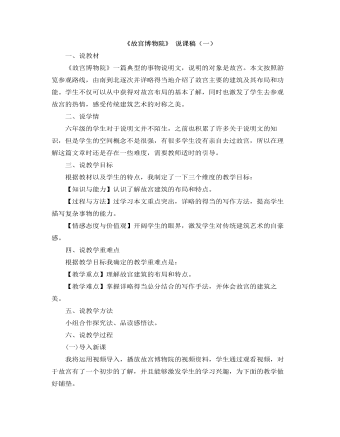
部编人教版六年级上册《故宫博物院》说课稿(一)
一、说教材《故宫博物院》一篇典型的事物说明文,说明的对象是故宫。本文按照游览参观路线,由南到北逐次并详略得当地介绍了故宫主要的建筑及其布局和功能。学生不仅可以从中获得对故宫布局的基本了解,同时也激发了学生去参观故宫的热情,感受传统建筑艺术的对称之美。二、说学情六年级的学生对于说明文并不陌生,之前也积累了许多关于说明文的知识,但是学生的空间概念不是很强,有很多学生没有亲自去过故宫,所以在理解这篇文章时还是存在一些难度,需要教师适时的引导。三、说教学目标根据教材以及学生的特点,我制定了一下三个维度的教学目标:【知识与能力】认识了解故宫建筑的布局和特点。【过程与方法】过学习本文重点突出,详略的得当的写作方法,提高学生描写复杂事物的能力。【情感态度与价值观】开阔学生的眼界,激发学生对传统建筑艺术的自豪感。
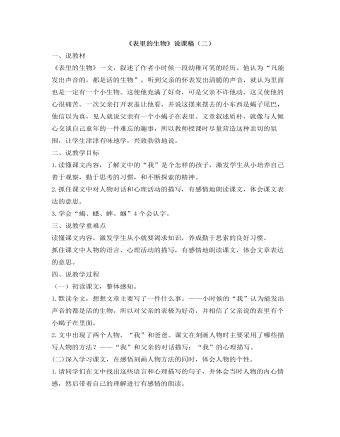
部编人教版六年级下册《表里的生物》说课稿(二)
一、说教材《表里的生物》一文,叙述了作者小时候一段幼稚可笑的经历。他认为“凡能发出声音的,都是活的生物”,听到父亲的怀表发出清脆的声音,就认为里面也是一定有一个小生物。这使他充满了好奇,可是父亲不许他动,这又使他的心很痛苦。一次父亲打开表盖让他看,并说这摆来摆去的小东西是蝎子尾巴,他信以为真,见人就说父亲有一个小蝎子在表里。文章叙述质朴,就像与人倾心交谈自己童年的一件难忘的趣事,所以教师授课时尽量营造这种亲切的氛围,让学生津津有味地学,兴致勃勃地说。二、说教学目标1.读懂课文内容,了解文中的“我”是个怎样的孩子,激发学生从小培养自己善于观察,勤于思考的习惯,和不断探索的精神。2.抓住课文中对人物对话和心理活动的描写,有感情地朗读课文,体会课文表达的意思。


